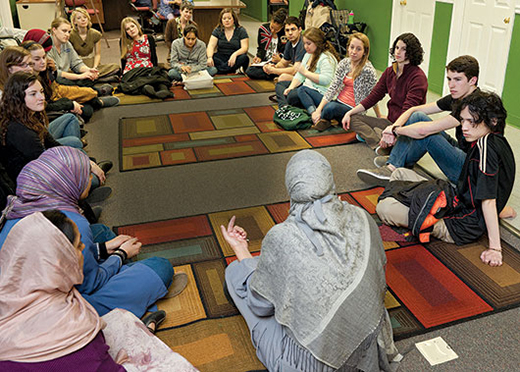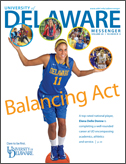
No passport needed to experience Muslim life
ON THE GREEN | When Patricia Sloane-White speaks of Muslim Delaware, she’s often met with a look of disbelief from students, members of the community and colleagues, who all ask the same question: Well, where is it?
“Right here,” she answers. “We don’t have to go to the Middle East to learn how Muslim people live in the modern world today.”
In fact, Sloane-White has developed a course to, as she describes it, “bring people face-to-face with the people who make up Muslim Delaware.”
During spring semester, Anthropology 267 was composed of 15 undergraduates, nearly half of whom had some familiarity with the Middle East, either through coursework or study abroad, and another half who admittedly “knew nothing and wanted to learn more.”
The course, titled “Muslim Delaware,” was co-taught by Sloane-White, an associate professor of anthropology and director of the Islamic Studies program at UD, and Amna Latif, whose husband is a professor in the Lerner College of Business and Economics.
Its goal, Sloane-White says, was for students to communicate with and learn from others “the essence of humanistic anthropology and Islamic social relations.”
In addition to classroom discussions, the students participated in site visits, which included trips to the Islamic Society of Delaware to learn about prayer, the mosque and its role in the community; the Masjd Al Kauthar to better understand the Black American Muslim experience; and the Tarbiyah School to study and witness the role of the private Islamic school.
On a separate outing—a meeting with the Tarbiyah Sisters Group—the students and a group of Muslim women all sat in a circle on the floor.
“This is the way the Prophet sat,” explained Miriam, president of the Tarbiyah School Board and leader of the weekly women’s group. “It’s a way to bring us closer together,” she added, as the class and community began an extensive discourse on women in Islam.
Active participation in the course was mandatory. All students were required to keep an anthropological field journal, and the course also maintained a closed Facebook page, in which students shared articles, posted videos and commented on their reactions to class discussions, required readings and field trips.
Early in the semester, one student uploaded a photo from “the only mosque I’ve visited so far” from his hometown of Taipei, Taiwan. The Facebook group was a forum for students to continue the conversation and ask questions.
“Why does the person doing the call to prayer cover their ears with their hands?” asked one student. “Does the Quran specifically define men and women’s natures?” asked another. “Is a Muslim widow allowed to remarry if she has children?”
While Sloane-White and Latif answered some questions, they left the discussions largely open-ended for the other students. Even the site visits were primarily exchanges between students and community leaders, with the professors listening far more then lecturing.
“As an anthropologist, one conversation is in some ways worth a semester of reading,” says Sloane-White. “What I find most amazing is the absolute willingness and degree of engagement from both students and the community.
“The students have a real desire to know more. And we’ve been welcomed—literally embraced—by the community, who say, ‘Please come again. Learn more. Understand and get to know us.’”
Article by Artika Rangan Casini, AS05






